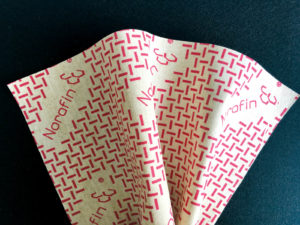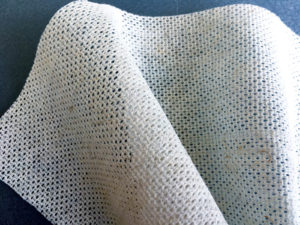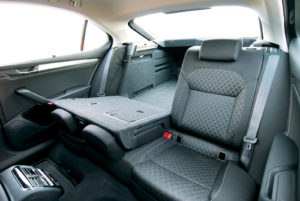
“I just want to say one word to you. Just one word. Plastics.”
When Dustin Hoffman’s character Benjamin Braddock heard those words in the iconic movie The Graduate in 1967, the use of plastics—or polymer-based materials—was on the rise. (This, although plastics had been around for almost 100 years; the first synthetic polymer was invented in 1869 by John Wesley Hyatt.)
“I read somewhere that in 1960, automotive vehicles used about 20 pounds of plastic or polymer-based materials,” says Matt Winslow, COO of Cerion Advanced Materials, a Rochester, N.Y.-based company that is focused on the development, customization and manufacturing of specialty inorganic advanced materials for industrial products. “Now they’re using more than 300 pounds per car. So you think of the 1960s as the age of plastics, but it is really now—and that’s inclusive of nonwovens.”
The use of nonwovens in automobiles is indeed on the rise. According to the EDANA (European Disposables and Nonwovens Association) website: “Today more than 40 automotive parts are made with nonwoven fabrics, from trunk liners and carpets to air and fuel filters.”
Mature growth
The reasons automotive manufacturers choose nonwoven materials for so many applications are many, including low production cost, excellent vibration dampening, soft aesthetics and customizability, according to Robert Baldy, market manager, nonwovens, of Americhem, Cuyahoga Falls, Ohio, a company that specializes in custom color and additive masterbatch solutions. “In addition, their construction is highly moldable, and they are relatively lightweight,” he says. “All of these factors make the use of nonwoven fabrics attractive in a variety of industries, including automotive.”

As in any other market, the automotive nonwovens market is a combination of mature products, new products and emerging innovations. Charlotte, N.C.-based Consolidated Fibers provides fibers to a variety of industries, including automotive. “While this is a mature market for us, there’s growth,” says Bob Kunik, Consolidated Fibers president. “We’re seeing some increased demand in black low-melt, as well as crystalline low-melt.
“Most of the low-melts are amorphous in structure,” he continues. “But in certain automotive end uses, such as wheel wells, there’s a demand for the crystalline structure because it makes for a more rigid and firmer product.”
Playing well with others
Nonwovens manufacturers are reaching out to companies such as Cerion to develop customized advanced and nano-sized materials to incorporate them into nonwovens for automobiles. “We’re working with these companies to disperse materials stably or affix them to substrates in polymer-based systems,” Winslow says. “We’re getting a wide variety of requests. There is a great deal of interest in fire resistance for specific materials in automobiles, in lightweighting, UV filtration and abrasion resistance.”
“We’re also working on strengthening for nonwovens,” adds Theresa Hendrick, technical research analyst for Cerion. “One difference between nonwoven materials and woven materials is that the strength and durability of nonwovens is generally not as good as woven materials.”

The primary challenge, Hendrick and Winslow point out, is to develop ways to incorporate nanoparticles onto the substrates so that they’ll be compatible and perform well. “Take zirconia for instance,” Winslow says. “There’s a great deal of research that supports the idea that zirconia strengthens certain properties of fibers in nonwovens. It’s just a matter of how we can stably disperse the zirconia nanoparticles onto the nonwoven systems and ensure they are compatible.”
Whether the particles are incorporated during the finishing process as a topical coating or during fiber production, compatibility is the biggest challenge, Hendrick says. “If you have an inorganic nanoparticle and an organic polymer fiber, you need to create a compatibility between the two to have the most optimized performance.”
Cerion isn’t always given a complete window into the processes manufacturers use due to the competitive nature of the business. “Some are proprietary and some customers just want them to remain confidential,” Winslow says. “We ask questions such as: What kind of temperatures are going to be occurring during the process? How long does processing take? What is the coating process? Sometimes we’re given that information and sometimes we’re not.”
Maintaining particle integrity in the end performance when it goes through processing is the goal. “Collaboration is key from our end in working with nonwoven companies and knowing what properties are important to them,” Hendrick says. “Once we know that, we can suggest nanoparticles that will further enhance or contribute those properties to their end use system—including optimal particle size, how it’s provided to them, if it’s coated, if the particle is surface functionalized and what materials we have to avoid having in our final product.”
Prioritizing sustainability

The pressure is on every industry to make sustainability a priority, and the nonwoven market is no exception. But sustainability is a broad term—materials, processes and logistics all play a part. “Sustainability is a very big issue with automotive and becomes more and more demanding,” says Stuart Smith, business director at Norafin (Americas) Inc., based in Mills River, N.C.
“That presents its own challenges with manufacturing nonwovens, particularly because some of the fibers you’ve got to use are not the easiest to run. You’ve also always got to bear in mind the cost with the materials. The challenge is to develop the right materials for the right value.”
Nonwovens already have a more sustainable footprint than many polymer-based materials, due to their lighter weight. “This has the net effect of reducing CO2 emissions and driving lower fuel than other materials,” Baldy says. “Additionally, most nonwoven materials are easily recyclable, use recycled content in their construction, or both. The industry is also closely following developments in sustainable polymers, and many manufacturers are beginning to develop product platforms based on biopolymers.”
Norafin is one company working to develop product platforms based on biopolymers. Its natural fiber of choice is flax. “We chose flax because it’s a natural fiber that is extremely strong and durable, along with several other performance aspects,” Smith says. “We’re developing it not just for the automotive industry but for others as well. It’s a good environmental story all the way around.”
Among the challenges with using flax fibers is that they process differently because they are not consistent. “It’s the same as with cotton or any natural fiber,” Smith says. “The fibers are not always the same length or diameter, and that can create challenges when you’re trying to process them. You’ve got to adapt your processing to be able to handle them.”

Norafin is one of the only companies making spun lace out of flax, Smith says. “We have a number of flax-based materials in the development stage for the automotive industry. We’re trying to get close to the demands of the industry so we can have something at the ready.”
The move to create lighter weight vehicles is on the forefront of sustainability for the industry, which affects the nonwoven arena not only in terms of the weight of the nonwovens, but also in terms of filtration and emissions. “OEMs [original equipment manufacturers] are being charged with making lighter engines that have improved fuel efficiency, but they are also being told to reduce emissions,” Winslow says. “But those two objectives are really opposed. Many new gasoline direct-injected engines and lightweight setups are more fuel-efficient, but also have new emissions issues.”
For the nonwoven filtration sector, that puts the focus on how to reduce the particulates in the emissions—and companies are turning to nanosized oxide catalysts to do that. “We have a wide spectrum of materials that are used in catalytic reactions,” Winslow says. “We’re experts in making those ultra-small, finely tuned particles of specific oxides. The exposed surfaces where the catalytic reaction occurs are much greater using smaller nanoparticles—so a 5 nanometer particle may be a more effective catalyst than a 50 or 100 nanometer particle.”
The second part of the equation is that those particles need to survive volatile conditions. “With an engine, you’re talking about testing for tens of thousands of miles,” Winslow says. “When you’re talking about a particulate trap, the catalytic materials need to perform at a certain level for 100,000 miles. And if they agglomerate and grow to 200 nanometers, for example, then they’re not effective anymore.”
The primary challenge with automotive filtration, no matter what the conditions, is to develop it so it performs over the long term. It’s one of many specific challenges the industry faces regarding sustainability, which always point to the same goal—to think about the long term.
“Going forward I don’t expect it to get any easier with sustainability—but that’s a good thing,” Smith says. “It needs to go in that direction. And who knows what the possibilities and challenges will be in the future?”
Sigrid Tornquist is a writer and editor based in Minneapolis, Minn., and a regular contributor to the Review.
Scientists know much about the properties that different nanoparticles can bring to nonwoven applications. How to effectively incorporate them, however, is a challenge. Below, Cerion’s Matt Winslow and Theresa Hendrick fill us in on a few of the possible applications for different inorganic nanoparticles:
Aluminum oxide: Provides durability, abrasion resistance and flame retardance.
Silica: Provides durability, abrasion resistance, and repels water and dirt.
Silver: Provides antimicrobial resistance and electrical conductivity.
Titanium dioxide: Provides antimicrobial resistance, contains photocatalytic properties, is moisture absorbent, self-cleaning, UV protective and repels water and dirt.
Zinc oxide: Provides durability, stiffness and abrasion resistance, contains photocatalytic properties, is antimicrobial, self-cleaning and offers UV protection.
"With the ‘internet of things’ where there are touch screens and different devices communicating with each other, we’re also seeing a great deal of interest in making surfaces conductive that are not normally conductive. Can you make the steering wheel conductive so it can communicate with other parts of the car? We’re creating custom silver metallic nanoparticles dispersed in various polymer systems to coat a wide variety of substrates to create conductive networks." - Matt Winslow, Cerion
 TEXTILES.ORG
TEXTILES.ORG




